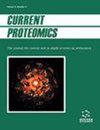蛇毒中一种新的降血压肽(Bj)的表征
IF 0.5
4区 生物学
Q4 BIOCHEMICAL RESEARCH METHODS
引用次数: 0
摘要
背景:蛇毒已成为许多与血液凝固和神经元毒性有关的生物活性肽、酶和毒素的重要来源。过去,人们从蛇毒中分离出了许多缓激肽增效肽,这些肽具有抑制血管紧张素转换酶(ACE)的活性,因而具有降血压活性。人们对分离、鉴定和设计肽类似物作为强效 ACE 抑制剂产生了浓厚的兴趣,这些类似物可用于治疗高血压和相关疾病。目的:本研究旨在从 Bothrops Jararaca(Bj)蛇的毒液中寻找新的生物活性肽。目的:本研究的目的是在 Bothsrop Jararaca (Bj) 蛇毒中寻找新的生物活性肽:目的是从 Bj 毒液中分离并鉴定新的降压肽。研究方法:我们对已知含有一系列生物活性肽的 Bj 毒液进行了研究。我们分离出了一种新的多肽(BJ-1),它在体外显示出强大的降血压活性。通过 Sephadex G25 柱层析和 RP-HPLC 对该肽进行了纯化。通过质谱分析、氨基酸分析、N-端测序和化学合成对其进行了表征。结果:经鉴定,该肽为八十肽,氨基酸序列为 DCPSDWSSYEGHCYKPFS,其中两个 Cys 残基可能以游离状态存在,但氧化后可形成内部 S-S 键。通过与固相化学法制备的合成肽进行比较,我们完全证实了这一点。两者具有相同的分子质量(2 108 Da)和相同的生物活性。此外,我们还推断 BJ-1 可能来自前体蛋白 "凝血因子 IX/因子 X 结合蛋白(CF-IX/X-BP)",是在其 A 链的 N 端,即 KPFS18ↆE 19PKN 序列内,通过蛋白水解作用裂解而来。该裂解位点包含 PCSK8(蛋白转换酶 Subtilisin Kexin8)又称 Subtilisin Kexin Isozyme 1(SKI-1)或 Site 1 Protease(S1P)。尽管观察到了这一点,但通过使用包含拟议裂解位点的合成肽和重组 PCSK8 酶,我们发现负责生成 BJ-1 的酶并非 PCSK8。还需要进一步研究来确定相关的酶,并充分描述该肽的药理和生物学特性。结论我们的研究揭示了一种新的降血压八十肽存在于蛇类 Bothrops jararaca 的毒液中。它很可能来自蛋白质 CF-IX/X-BP 的 A 链,在 N 端被一种蛋白酶蛋白水解裂解,这种蛋白酶的特性尚待确定。本文章由计算机程序翻译,如有差异,请以英文原文为准。
Characterization of a New Hypotensive Peptide from the Venom of Snake bothrops jararaca (Bj)
Background: Snake venom has become a key source of many bioactive peptides, enzymes, and toxins associated with blood coagulation and neuronal toxicity. In the past, a number of bradykinin potentiating peptides have been isolated from snake venom that display hypotensive activity due to their inhibitory activity towards Angiotensin-Converting Enzyme (ACE). Significant interest has developed to isolate, characterize, and subsequently design peptide analogs as potent ACE-inhibitors which may find therapeutic applications for the treatment of hypertension and associated diseases. Aim: The aim of this study is to search for new bioactive peptide/s in the venom of the snake Bothrops Jararaca (Bj). Objective: The objective is to isolate and characterize new hypotensive peptides from BJ venom. Methodology: We examined the venom of Bj which is known to host a range of bioactive peptides. We have isolated a new peptide (BJ-1) which displayed in vitro potent hypotensive activity. The peptide was purified via Sephadex G25 column chromatography and RP-HPLC. It was characterized by mass spectrometry, amino acid analysis, N-terminal sequencing, and chemical synthesis. Result: The peptide was identified as an octa-decapeptide with an amino acid sequence as DCPSDWSSYEGHCYKPFS where the two Cys residues are likely present in a free state, although they can form an internal S-S bond upon oxidation. It was fully confirmed by comparing it with synthetic peptides prepared by solid phase chemistry. Both have the same molecular mass (2,108 Da) and identical bioactivity. Furthermore, we rationalize that BJ-1 may be derived from precursor protein “Coagulation factor IX/factor X binding protein (CF-IX/X-BP)” by proteolytic cleavage at the Nterminus of its A-chain within the sequence KPFS18ↆE 19PKN. This cleavage site contains the recognition motif of enzyme PCSK8 (Proprotein Convertase Subtilisin Kexin8) also known as Subtilisin Kexin Isozyme 1 (SKI-1) or Site 1 Protease (S1P). Despite this observation, using a synthetic peptide encompassing the proposed cleavage site and recombinant PCSK8 enzyme, we found that the enzyme responsible for the generation of BJ-1 is not PCSK8. Further studies will be needed to identify the associated enzyme and fully characterize the pharmacological and biological properties of the peptide. Conclusion: Our study revealed the presence of a novel hypotensive octa-decapeptide in the venom of the snake Bothrops jararaca. It is likely derived from the A-chain of protein CF-IX/X-BP via proteolytic cleavage at the N-terminus by a protease yet to be characterized
求助全文
通过发布文献求助,成功后即可免费获取论文全文。
去求助
来源期刊

Current Proteomics
BIOCHEMICAL RESEARCH METHODS-BIOCHEMISTRY & MOLECULAR BIOLOGY
CiteScore
1.60
自引率
0.00%
发文量
25
审稿时长
>0 weeks
期刊介绍:
Research in the emerging field of proteomics is growing at an extremely rapid rate. The principal aim of Current Proteomics is to publish well-timed in-depth/mini review articles in this fast-expanding area on topics relevant and significant to the development of proteomics. Current Proteomics is an essential journal for everyone involved in proteomics and related fields in both academia and industry.
Current Proteomics publishes in-depth/mini review articles in all aspects of the fast-expanding field of proteomics. All areas of proteomics are covered together with the methodology, software, databases, technological advances and applications of proteomics, including functional proteomics. Diverse technologies covered include but are not limited to:
Protein separation and characterization techniques
2-D gel electrophoresis and image analysis
Techniques for protein expression profiling including mass spectrometry-based methods and algorithms for correlative database searching
Determination of co-translational and post- translational modification of proteins
Protein/peptide microarrays
Biomolecular interaction analysis
Analysis of protein complexes
Yeast two-hybrid projects
Protein-protein interaction (protein interactome) pathways and cell signaling networks
Systems biology
Proteome informatics (bioinformatics)
Knowledge integration and management tools
High-throughput protein structural studies (using mass spectrometry, nuclear magnetic resonance and X-ray crystallography)
High-throughput computational methods for protein 3-D structure as well as function determination
Robotics, nanotechnology, and microfluidics.
 求助内容:
求助内容: 应助结果提醒方式:
应助结果提醒方式:


